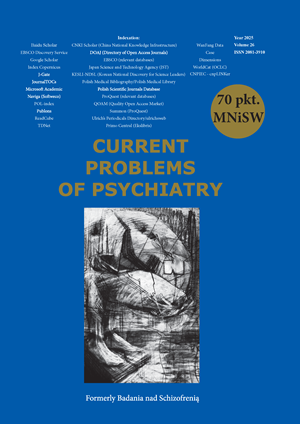Measuring depression as a short-term state and as a trait: multilevel approach
DOI:
https://doi.org/10.12923/2353-8627/2025-0006Słowa kluczowe:
depresja, stan, cecha, DASS-21, podejście wielopoziomoweAbstrakt
Wstęp: Teoria Całościowej Cechy pozwala na konceptualizację konstruktów jako krótkotrwałego stanu i jako cechy. Depresja również może być rozumiana na dwa sposoby, jako krótkotrwały stan i jako cecha. Celem naszego badania była weryfikacja struktury czynnikowej skali depresji zarówno na poziomie inter-, jak i intraindywidualnym oraz zbadanie korelacji między gęstością stanu depresji a depresją jako cechą.
Materiał i metody: W badaniu wykorzystano skalę depresji DASS-21 i przeprowadzono trwające 14 dni badanie dzienniczkowe oparte o pomiar powtarzany na próbie 147 osób (zbadano 49.3% kobiet oraz 50.7% mężczyzn). Badanie przeprowadzono za pomocą ankiety internetowej, w której pozycje skali były wyświetlane w losowej kolejności dla każdej osoby każdego dnia. Respondenci codziennie oceniali intensywność wskaźników depresji.
Dyskusja: Dwupoziomowa konfirmacyjna analiza czynnikowa dowiodła, że struktury jednoczynnikowe są najlepszym sposobem na wyjaśnienie między- i wewnątrzindywidualnej wariancji depresji. Rzetelność dla pomiaru depresji jako stanu i jako gęstości stanów była wysoka. Korelacja uśrednionego pomiaru depresji jako stanu z jednorazowym pomiarem depresji jako cechy była bardzo silna, dostarczając tym samym empirycznych dowodów na słuszność głównej tezy Teorii Całościowej Cechy.
Wnioski: Niniejsze badanie otwiera nowe możliwości pomiaru depresji w badaniach i praktyce klinicznej przy użyciu powtarzanych pomiarów depresji jako stanu. Badanie dynamiki zmian w stanach depresji pozwala na bardziej precyzyjne przewidywanie tendencji danej osoby do doświadczania depresji.
Bibliografia
1. Spielberger C.D. State-Trait Depression Scales (Form X-1). Palo Alto, CA; Mind Garden: 1995.
2. Ritterband L.M., Spielberger C.D. Construct validity of the Beck Depression Inventory as a measure of state and trait depression in nonclinical populations. Depression and Stress. 1996; 2: 123-145.
3. Mayerl H., Schultz A., Freidl W., Stolz E. Short-term dynamics of loneliness and depressive symptoms: Gender differences in older adults. Arch Gerontol Geriatr. 2024; 123: 105423. https://doi.org/10.1016/j.archger.2024.105423
4. Nezlek J. B. A multilevel framework for understanding relationships among traits, states, situations, and behaviors. Eur J Pers. 2007; 21: 789-810. https://doi.org/10.1002/per.640
5. Fleeson W., Jayawickreme E. Whole trait theory. J Res Pers. 2015; 56: 82-92.
6. Allen B. P., Potkay C. R. On the arbitrary distinction between states and traits. J Pers Soc Psychol. 1981; 41(5): 916-928. https://doi.org/10.1037/0022-3514.41.5.916
7. Chaplin W. F., John O. P., Goldberg L. R. Conceptions of states and traits: Dimensional attributes with ideals as prototypes. J Pers Soc Psychol. 1988; 54(4): 541-557. https://doi.org/10.1037/0022-3514.54.4.541
8. Fridhandler B. M. Conceptual note on state, trait, and the state-trait distinction. J Pers Soc Psychol. 1986; 50(1): 169-174. https://doi.org/10.1037/0022-3514.50.1.169
9. Zuckerman M. The Distinction Between Trait and State Scales Is Not Arbitrary: Comment on Allen and Potkay's 'On the Arbitrary Distinction Between Traits and States'. J Pers Soc Psychol. 1983; 5: 1083-1089. https://doi.org/10.1037/0022-3514.44.5.1083
10. Spielberger C. D. Cross-cultural assessment of emotional states and personality traits. Eur Psychol. 2006; 11: 297-303. https://doi.org/10.1027/1016-9040.11.4.297
11. Steyer R., Mayer A., Geiser C., Cole D. A. A theory of states and traits. Revised. Annu Rev Clin Psychol. 2015; 11(1): 71-98. https://doi.org/10.1146/annurev-clinpsy-032813-153719
12. Fleeson W. Toward a structure- and process- integrated view of personality: Traits as density distributions of states. J Pers Soc Psychol. 2001; 80(6): 1011-1027. https://doi.org/10.1037/0022-3514.80.6.1011
13. Fleeson W., Furr R.M., Jayawickreme E., Helzer E.G., Hartley A.G., Meindl P. Personality science and the foundations of character. W: Miller C.B., Furr R.M., Knobel A., Fleeson W. red., Character: New directions from philosophy, psychology, and theology. Oxford; Oxford University Press: 2015: 41-71. https://doi.org/10.1093/acprof:oso/9780190204600.003.0003
14. Horstmann K. T., Rauthmann J. F., Sherman R. A., Ziegler M. Unveiling an exclusive link: Predicting behavior with personality, situation perception, and affect in a preregistered experience sampling study. J Pers Soc Psychol. 2021; 120(5): 1317-1343. https://doi.org/10.1037/pspp0000357
15. Rauthmann J. F., Horstmann K. T., Sherman R. A. Do self-reported traits and aggregated states capture the same thing? A nomological perspective on trait-state homomorphy. Soc Psychol Personal Sci. 2019; 10(5): 596-611. https://doi.org/10.1177/1948550618774772
16. Fleeson W., Gallagher P. The implications of Big Five standing for the distribution of trait manifestation in behavior: Fifteen experience-sampling studies and a meta-analysis. J Pers Soc Psychol. 2009; 97(6): 1097-1114. https://doi.org/10.1037/a0016786
17. Nübold A., Hülsheger U. R. Personality states mediate the effect of a mindfulness intervention on employees' work outcomes: A randomized controlled trial. Eur J Pers. 2021; 35(4): 646-664. https://doi.org/10.1177/08902070211012915
18. Finnigan K. M., Vazire S. The incremental validity of average state self-reports over global self-reports of personality. J Pers Soc Psychol. 2018; 115(2): 321-337. https://doi.org/10.31234/osf.io/djknb
19. Fleeson W., Leicht C. On delineating and integrating the study of variability and stability in personality psychology: Interpersonal trust as illustration. J Res Pers. 2006; 40(1): 5-20. https://doi.org/10.1016/j.jrp.2005.08.004
20. Zuroff D. C., Sadikaj G., Kelly A. C., Leybman M. J. Conceptualizing and measuring self-criticism as both a personality trait and a personality state. J Pers Assess. 2016; 98(1): 14-21. https://doi.org/10.1080/00223891.2015.1044604
21. Ohly S., Sonnentag S., Niessen C., Zapf D. Diary studies in organizational research: An introduction and some practical recommendations. J Pers Psychol. 2010; 9(2): 79-93. https://doi.org/10.1027/1866-5888/a000009
22. Hektner J.M., Schmidt J.A., Csikszentmihalyi M. Experience sampling method: Measuring the quality of everyday life. Thousand Oaks, CA; Sage: 2007.
23. Chisholm D., Sweeny K., Sheehan P., Rasmussen B., Smit F., Cuijpers P., Saxena S. Scaling-up treatment of depression and anxiety: a global return on investment analysis. Lancet Psychiatry. 2016; 3(5): 415-424. https://doi.org/10.1016/s2215-0366(16)30024-4
24. World Health Organization. International Statistical Classification of Diseases and Related Health Problems. 11th Ed. Geneva; World Health Organization: 2019.
25. American Psychiatric Association. Diagnostic and Statistical Manual of Mental Disorders. 5th ed. Arlington, VA; American Psychiatric Association; 2013. https://doi.org/10.1176/appi.books.9780890425596
26. Teasdale J. D. Cognitive vulnerability to persistent depression. Cogn Emot. 1988; 2: 247-274.
27. Haaga D. A., Beck A. T. Perspectives on depressive realism: Implications for cognitive theory of depression. Behav Res Ther. 1995; 33(1): 41-48. https://doi.org/10.1016/0005-7967(94)e0016-c
28. Dumenci L., Windle M. A latent trait-state model of adolescent depression using the Center for Epidemiologic Studies-Depression Scale. Multivariate Behav Res. 1996; 31: 313-330. https://doi.org/10.1207/s15327906mbr3103_3
29. Altweck L., Freund J., Hahm S., Schmidt S., Tomczyk S. Collective loneliness: The impact of the social network on loneliness and depression during the coronavirus pandemic in older Europeans. Int J Geriatr Psychiatry. 2024; 39(1): e6045. https://doi.org/10.1002/gps.6045
30. Di Blas L., Borella M., Ferrante D. Short-term effects of fluctuations in self-esteem, perceived stress and loneliness on depressive states. Psihologijske Teme. 2021; 30(1): 99-114. https://doi.org/10.31820/pt.30.1.5
31. Krohne H. W., Schmukle S. C., Spaderna H., Spielberger C. D. The State-Trait Depression Scales: An International Comparison. Anxiety Stress Coping. 2002; 15(2): 105-122. https://doi.org/10.1080/10615800290028422
32. Vera-Villarroel P., Buela-Casal G., Celis-Atenas K., Córdova-Rubio N., Encina-Olea N., Spielberger C. D. Chilean experimental version of the State-Trait Depression Questionnaire (ST-DEP): Trait sub-scale (T-DEP). Int J Clin Health Psychol. 2008; 8(2): 563-575. https://doi.org/10.2466/pr0.106.1.65-77
33. Lovibond S.H., Lovibond P.F. Manual for the Depression Anxiety Stress Scales. 2nd ed. Sydney; Psychology Foundation: 1995. https://doi.org/10.1037/t01004-000
34. Clark L. A., Watson D. Tripartite model of anxiety and depression: psychometric evidence and taxonomic implications. J Abnorm Psychol. 1991; 100(3): 316-336. https://doi.org/10.1037/0021-843x.100.3.316
35. Lovibond P. F., Lovibond S. H. The structure of negative emotional states: Comparison of the Depression Anxiety Stress Scales (DASS) with the Beck Depression and Anxiety Inventories. Behav Res Ther. 1995; 33(3): 335-343. https://doi.org/10.1016/0005-7967(94)00075-u
36. Depression Anxiety Stress Scales (DASS) [strona domowa w Internecie]. Sydney: University of New South Wales; 2007 [aktualizowana 5 marca 2007; cytowana 22 marca 2025]. Dostępna z: http://www2.psy.unsw.edu.au/dass
37. Gomez R., Stavropoulos V., Griffiths M. D. Confirmatory factor analysis and exploratory structural equation modelling of the factor structure of the Depression Anxiety and Stress Scales-21. PLoS ONE. 2020; 15: e0233998. https://doi.org/10.1371/journal.pone.0233998
38. González-Rivera J. A., Pagán-Torres O. M., Pérez-Torres E. M. Depression, Anxiety and Stress Scales (DASS-21): construct validity problem in Hispanics. Eur J Investig Health Psychol Educ. 2020; 10: 375-389. https://doi.org/10.3390/ejihpe10010028
39. Park S. H., Song Y. J., Demetriou E. A., Pepper K. L., Thomas E. E., Hickie I. B., et al. Validation of the 21-item Depression, Anxiety, and Stress Scales (DASS21) in individuals with autism spectrum disorder. Psychiatry Res. 2020; 291: e113300. https://doi.org/10.1016/j.psychres.2020.113300
40. Randall D., Thomas M., Whiting D., McGrath A. Depression Anxiety Stress Scales (DASS-21): factor structure in traumatic brain injury rehabilitation. J Head Trauma Rehabil. 2017; 32: 134-144. https://doi.org/10.1097/htr.0000000000000250
41. Antony M. M., Bieling P. J., Cox B. J., Enns M. W., Swinson R. P. Psychometric properties of the 42-item and 21-item versions of the depression anxiety stress scales in clinical groups and a community sample. Psychol Assess. 1998; 10(2): 176-181. https://doi.org/10.1037/1040-3590.10.2.176
42. Patias N. D., Machado W. L., Bandeira D. R., Dell’Aglio D. D. Depression Anxiety and Stress Scale (DASS21) – Short Form: Adaptação e Validação para Adolescentes Brasileiros. Psico-USF. 2016; 21(3): 459-469. https://doi.org/10.1590/1413-82712016210302
43. Kyriazos T. A., Stalikas A., Prassa K., Yotsidi V. Can the depression anxiety stress scales short be shorter? Factor structure and measurement invariance of DASS-21 and DASS-9 in a Greek, non-clinical sample. Psychol. 2018; 9: 1095-1127. https://doi.org/10.4236/psych.2018.95069
44. Lee E. H., Moon S. H., Cho M. S., Park E. S., Kim S. Y., Han J. S., et al. The 21-item and 12-item versions of the depression anxiety stress scales: psychometric evaluation in a Korean population. Asian Nurs Res. 2019; 13: 30-37. https://doi.org/10.1016/j.anr.2018.11.006
45. Makara-Studzińska M., Tyburski E., Załuski M., Adamczyk K., Mesterhazy J., Mesterhazy A. Confirmatory Factor Analysis of Three Versions of the Depression Anxiety Stress Scale (DASS¬42, DASS-21, and DASS-12) in Polish Adults. Front Psychiatr. 2022; 12: e770532. https://doi.org/10.3389/fpsyt.2021.770532
46. Syahputra Y., Hafni M., Solihatun S., Istiana I., Rahmat C. P., Karisma S. P., Erwinda L. Confirmatory Factor Analysis of the DASS-18 Scale for Assessment of Depression, Anxiety, and Stress Symptoms. Madania J Ilmu-Ilmu Keislaman. 2024; 14(1): 17-25.
47. Henry J. D., Crawford J. R. The 21-item version of the Depression Anxiety Stress Scales (DASS-21): Normative data and psychometric evaluation in a large non-clinical sample. Br J Clin Psychol. 2005; 44: 227-239. https://doi.org/10.1348/014466505x29657
48. Kline R.B. Principles and practice of structural equation modeling. 4th ed. New York; Guilford Publications: 2016.
49. Muthén L.K., Muthén B.O. Mplus user’s guide. 7th ed. Los Angeles; Muthén & Muthén: 2015.
50. Hu L., Bentler P. M. Fit indices in covariance structure modeling: Sensitivity to underparameterized model misspecification. Psychol Methods. 1998; 3(4): 424-453. https://doi.org/10.1037/1082-989x.3.4.424
51. Sherman R. A., Rauthmann J. F., Brown N. A., Serfass D. G., Jones A. B. The independent effects of personality and situations on real-time expressions of behavior and emotion. J Pers Soc Psychol. 2015; 109: 872-888. https://doi.org/10.1037/pspp0000036
52. Su R., Stoll G., Rounds J. The nature of interests: Toward a unifying theory of trait-state interest dynamics. In: Vocational interests in the workplace. Routledge; 2019: 11-38. https://doi.org/10.4324/9781315678924-2
53. Baird B. M., Le K., Lucas R. E. On the nature of intraindividual personality variability: Reliability, validity, and associations with well-being. J Pers Soc Psychol. 2006; 90(3): 512-527. https://doi.org/10.1037/0022-3514.90.3.512
54. Clifton A., Kuper L. E. Self-reported personality variability across the social network is associated with interpersonal dysfunction. J Pers. 2011; 79(2): 359-390. https://doi.org/10.1111/j.1467-6494.2010.00686.x
55. McCabe K. O., Fleeson W. What is extraversion for? Integrating trait and motivational perspectives and identifying the purpose of extraversion. Psychol Sci. 2012; 23(12): 1498-1505. https://doi.org/10.1177/0956797612444904
Pobrania
Opublikowane
Numer
Dział
Licencja
Prawa autorskie (c) 2025 Autorzy

Utwór dostępny jest na licencji Creative Commons Uznanie autorstwa 4.0 Międzynarodowe.


